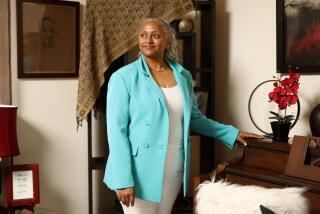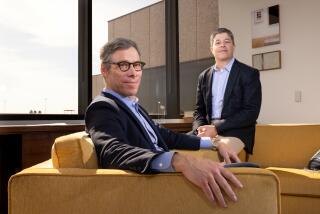SMALL BUSINESS : Solo Ad Venturer : High-Tech One-Man Agency Represents Next Wave as Industry Shrinks
- Share via
ENCINO — Rob Frankel, president of Frankel & Anderson advertising agency, works in a tiny office in his Encino home, where he dreams up ads on his Apple Macintosh computer. He also has an IBM PC-clone, a phone and a fax machine.
He has no employees, just occasional visits from his two dogs and his 2-year-old son. His closets are stuffed with floppy disks, his walls cluttered with movie posters and a photo of one of the actors who played Darrin Stephens, the advertising agency executive from the ‘60s TV show “Bewitched.”
But Frankel, 37, claims to represent the future of the advertising business, and he may just be right.
While many big ad agencies have been slow to incorporate computer technology into their businesses, Frankel said he’s been all-digital for about five years. Frankel composes ads on a computer--whether drawings, rearranging photos, or tinkering with copy, headlines and colors--then pushes a button to fax the ad to the client for approval. Better yet, if a client is on the Internet computer network, Frankel zaps a color, electronic version of the ad in a matter of seconds. He can even transmit TV commercials electronically, if the client is capable of receiving in that format.
Of course, most ad agencies these days use computers to compose and typeset ads the way that Frankel does. But even some of the largest agencies still haven’t integrated their computer systems among various departments, and rarely do they send ads to clients electronically. Some even still make presentations to prospective clients the old-fashioned way--on hand-drawn art boards.
Not only does Frankel charge less than big agencies, but he claims that technology has narrowed the quality gap, allowing him to produce ads comparable to those that big agencies spend months on--and in a fraction of the time.
This, at a time when the ad industry is trying to recover from its longest and bleakest drought in memory, with tens of thousands of layoffs. Critics contend that many large agencies remain bloated and inefficient, and their once-loyal advertisers are increasingly breaking ad accounts into pieces that are doled out to various firms.
As a result, observers say, more and more work is going to smaller, entrepreneurial agencies and non-traditional firms such as Hollywood talent agencies--who are seen as swifter, hipper and more responsive. Coca-Cola, for example, has defected from Madison Avenue to small ad agencies and high-powered Hollywood talent agency Creative Artists Agency. IBM, Burger King, MasterCard and Volkswagen also switched from large to small agencies.
“The information highway? They don’t get it,” Frankel said of big ad agencies. Most are “still structured like 1950s agencies. They’re still doing the Doris Day-Rock Hudson thing.”
Frankel is not alone in his view of big ad agencies. “There are some large agencies that are probably in a state of decline and are not going to make it because they’ve bureaucratized the whole advertising process,” said New York management consultant James Howard.
In his days working for big agencies, Frankel recalled, he would produce about one television spot and three print ads a year. He now completes a couple hundred jobs a year without breaking a sweat, claiming to take in gross revenues equivalent to an agency billing between $3.5 million and $6 million annually. (Advertising agencies typically keep from 7% to 15% of billings.)
Granted, that’s puny compared to billion-dollar agencies. And Frankel’s clients--from computer software firms and retailers to the California Lottery and Sea World--usually spend $500,000 or less on an ad campaign with him. But many major ad agencies that wouldn’t accept jobs that small in the 1980s now do.
Frankel said he gets most of his business through referrals from clients who like his “funny” style. For a Honda Sabre motorcycle ad, he created a glossy image of the bike imposed over photos of road signs with text that reads, “It was born under three different signs.” Another ad for a health club has a 100-pound bag of flour dressed in a bikini, with a reminder, “Just because you’re 100 lbs. doesn’t mean you look great in a bikini.”
Major ad agencies have also used Frankel anonymously to perform “ghost work” on some of their biggest accounts because his computer expertise allows him to turn assignments around so quickly, he claimed--although Frankel won’t reveal the names of these agencies.
Larger ad agencies generally have been slow to embrace computer technology because the main reason to do so was to cut costs, said Ron Lockhart, chief executive of Publications Directions, a New York consulting firm for graphics companies. “In the ad industry, all the charges are thrown right back to the client and marked up at the industry standard. There was no motivation for advertisers to do it.”
It’s only now that larger agencies are under pressure from smaller ones that they’ve begun to catch up, he said.
Not everyone agrees that big ad agencies are dinosaurs. BBDO Worldwide was “forced into (technology) early” because a major client is Apple Computer, which expects a certain degree of technological competence, said Patty Buss, vice president at BBDO in Los Angeles. “I think everyone is pretty much up to speed now.”
The view of big ad agencies as inefficient is “wishful thinking on the part of a lot of smaller agencies,” said Abbott C. Jones, managing director of AdMedia Corporate Advisors, a New York investment banking firm.
After their cutbacks and reorganizations, many big agencies are now leaner and more responsive to clients, Jones said. He noted that ad giants such as Interpublic Group, Omnicon Group and Foote Cone & Belding have growing revenues and earnings, and higher stock prices.
Still, Frankel argued that many large agencies remain bloated with middle management and archaic chains of command: A client will communicate with an account executive, who types a memo and sends it to his supervisor, who passes it on to the senior creative person, who dispatches the information to group heads. All the while, ideas bounce to and fro, from agency to advertiser, in meeting after meeting. Delivery service bills pile up.
“It’s a huge Ping-Pong game between the ad agency and the client, which actually becomes adversarial,” Frankel said.
As evidence that some agencies are technologically deficient, Frankel noted a recent agency review he conducted for a division of the Dutch consumer electronics giant Philips. Frankel, hired to advise Philips on which agency to select, heard presentations by several major agencies. He was astonished when two presented art boards that were drawn and pasted up by hand.
Frankel said he knows big ad agencies well because he’s worked for eight of them.
Fresh out of UC Berkeley, Frankel joined Foote, Cone & Belding as a writer. Over the next seven years he jumped from one agency to another, ending up at D’Arcy Masius Benton & Bowles. In 1986, he was asked to leave the agency over “style differences,” he said.
Then Frankel and art director Don Anderson started their own firm with a leased office and a few workers. Frankel later bought Anderson out, keeping the firm’s name.
By 1990, Frankel saw that technology had advanced so far that he could earn more by working alone. He set up his home office with $35,000 in equipment, and developed a network of photographers, illustrators, media buyers and other on-line service providers.
Along the way, Frankel has accepted stock or options in some of his clients in exchange for lower fees. Among the companies Frankel has equity in are Right Start Inc., a Westlake Village mail-order firm; GeoWorks, an Alameda software developer that recently raised more than $10 million in its initial public stock offering, and Adaptive Software Inc., a fast-growing Newport Beach developer of employee scheduling software.
Stan Fridstein, Right Start’s president, said Frankel started doing ad work for his company around 1985 when it couldn’t afford a big agency. He kept going back to Frankel even after Right Start grew into a much larger and profitable company because, Fridstein said, Frankel is “a streamed-down version of the sloth-like agencies.”
And soon, Frankel believes, the difference between cutting-edge ad agencies and others will be even more evident with the coming of interactive television. Some big ad agencies have formed divisions to study the matter. Frankel said he’s ready now to produce interactive ads, he’s just waiting for the market to develop.
More to Read
Inside the business of entertainment
The Wide Shot brings you news, analysis and insights on everything from streaming wars to production — and what it all means for the future.
You may occasionally receive promotional content from the Los Angeles Times.









